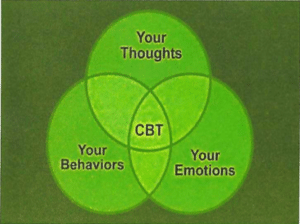
The following is the C.B.T. (Cognitive Behavioral Therapy) Equation
Your Thoughts = Your Feelings = Your Behaviors
Thoughts/Beliefs = Feelings = Behaviors = Results/Reality
The Chain Reaction: How It Works
Step 1: Thoughts/Beliefs
- What they are: Mental interpretations, assumptions, stories, or judgments about ourselves, others, or the world.
- Key point: Thoughts are not reality—they’re our meaning-making filter.
- Where they come from: Past experiences, cultural conditioning, upbringing, trauma, learned patterns.
- Automatic vs. Conscious:
-
- Automatic thoughts happen reflexively (often negative or limiting).
-
- Conscious thoughts are intentionally chosen or reframed.
Example:
- Automatic thought: “I always mess things up.”
- Chosen thought: “I’ve learned from mistakes before, and I can do it again.”
Step 2: Feelings/Emotions
- What they are: Bodily sensations + mental labels that arise from how we interpret situations (our thoughts).
- Thoughts are the cause, feelings are the effect—but this happens so fast, we often think feelings come “out of nowhere.”
- Emotions serve as an action signal—they nudge us toward certain behaviors.
Example:
- Thought: “This meeting will go terribly.”
- Feeling: Anxiety, tension, dread.
- Physical response: Sweaty palms, racing heart.
Step 3: Behaviors/Actions
- What they are: The choices we make or avoid making in response to our feelings.
- Emotions prime us for certain behaviors (e.g., fear primes us for avoidance, excitement primes us for approach).
- Behavior often reinforces the original belief, creating a self-fulfilling prophecy.
Example:
- Feeling anxious about a meeting → speaking less, avoiding eye contact.
- Others may perceive you as disengaged → reinforcing your belief that “I’m bad in meetings.”
Step 4: Results / Reality
- Our repeated behaviors produce tangible results (or lack thereof).
- Those results then feed back into our belief system, either strengthening the original thought or prompting change.
Example:
- Avoid speaking up in meetings → career growth slows → belief that “I have nothing valuable to contribute” becomes stronger.
- The Cycle in Motion
Belief → Emotion → Behavior → Result → Reinforced Belief
- Belief: “I’m not a good public speaker.”
- Emotion: Nervousness, self-consciousness.
- Behavior: Decline speaking opportunities.
- Result: No improvement, missed chances, others never see your skills.
- Reinforced Belief: “See? I’m just not cut out for it.”
- The Psychological Foundations
- Cognitive Behavioral Therapy (CBT) → focuses on changing thoughts to influence emotions and actions.
- Self-Perception Theory → we infer our beliefs by observing our own behavior.
- Neuroplasticity → repeatedly choosing new thoughts/behaviors rewires neural pathways, making new patterns easier over time.
- Reticular Activating System (RAS) → your brain selectively notices things that confirm your beliefs (confirmation bias).
-
Why This Creates Our “Reality”
- Your brain filters reality through your beliefs.
Two people in the same situation can have radically different experiences based purely on their interpretation.
- Over time, this feedback loop hardens into patterns of reality—your career path, relationships, health habits, etc.
- How to Change the Cycle
- Awareness → Notice your thoughts without judgment.
- Questioning → Ask: Is this thought true? Is it helpful?
- Reframing → Replace limiting thoughts with realistic, empowering ones.
- Behavioral experiments → Act “as if” the new belief is true and gather evidence.
- Emotional regulation → Use breathwork, mindfulness, or physical movement to shift state so new actions feel possible.
Quick Reframe Example
| Old Loop | New Loop |
| Thought: “I can’t network; I’m awkward.” | Thought: “I can learn to connect by asking good questions.” |
| Feeling: Social anxiety | Feeling: Curious openness |
| Behavior: Avoid networking events | Behavior: Attend and speak to 1 new person |
| Result: No contacts | Result: New acquaintance, slight confidence boost |

Recent Comments